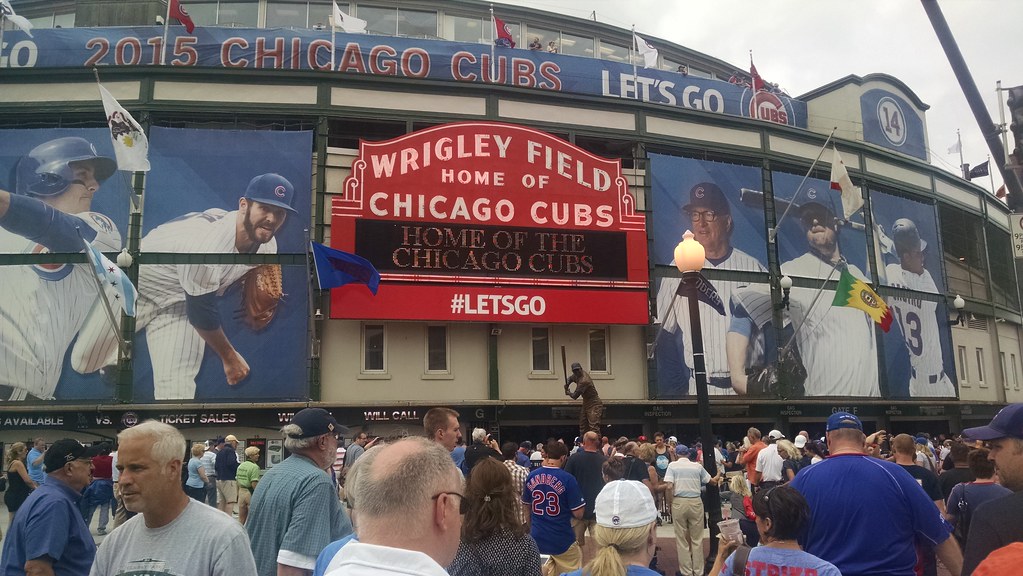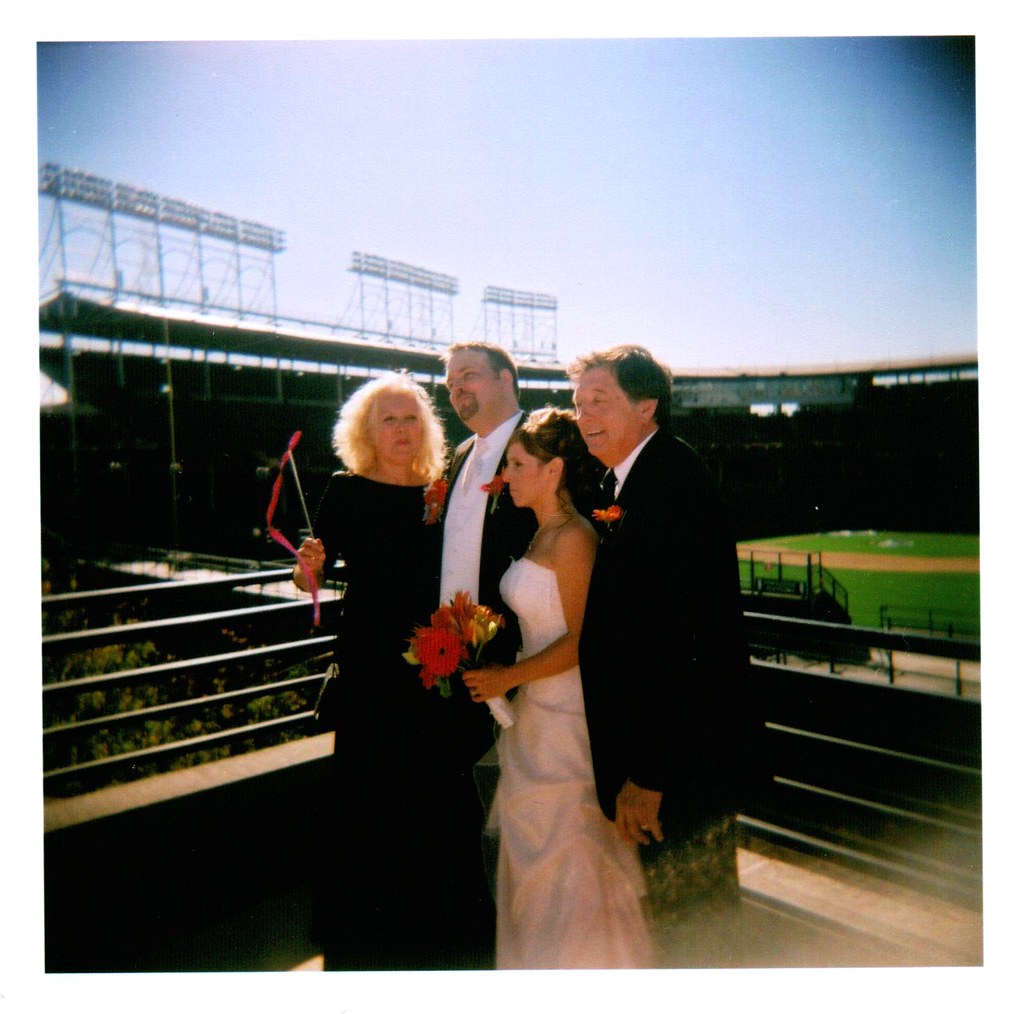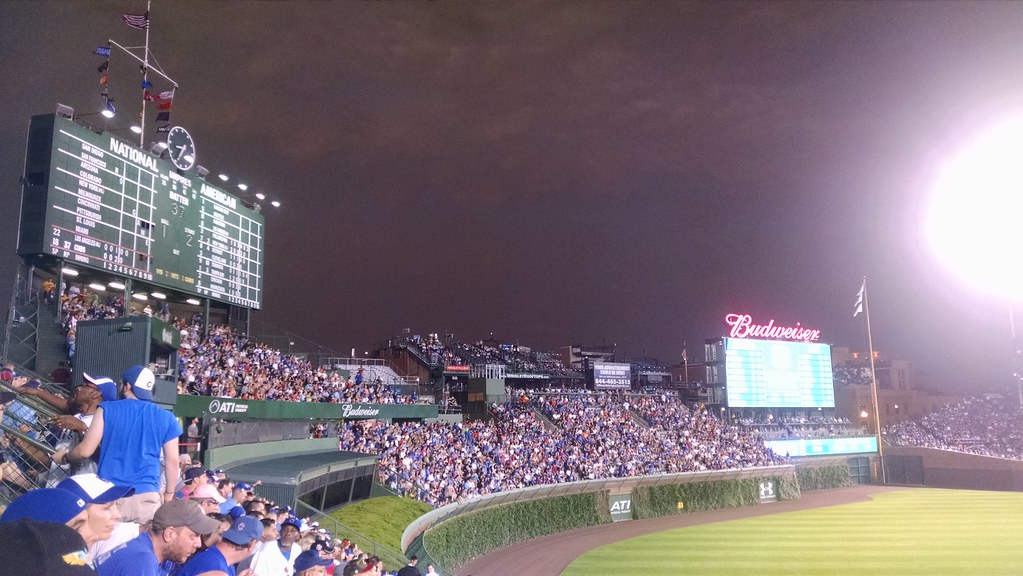
My mother had burst into tears on the phone, discussing how upset it made her to see her grandson, my 6 year old nephew, so heartbroken at the Cubs losing their first two NLCS playoff games against the NY Mets.
"This is our fault," she cried, "I think, oh what have we DONE to him?"
It could be considered a form of cruelty to indoctrinate children into the lifelong baseball heartbreak that runs through our family DNA, like a defective gene.
Being a fan of the Chicago Cubs ain't for sissies.
After hanging up, my coworker overhearing the conversation asked with a chuckle, "Remind me again... what's so great about being a Cubs fan?"
I slumped in my chair, rubbing my hands across my face and thought for a moment, "Being a Cubs fan is a character builder. It teaches you from a young age that you can face disappointment head on, and survive." It's easy to cheer for a winner. That takes no kind of real effort. You're constantly rewarded. It's very Pavlovian. The bell rings, you start to salivate. The team wins, you feel joy. You strut with the swagger of a champion (without actually having done anything yourself to deserve it).Cheering for the underdog, for a team with a hundred year history of jinxes, hexes and a multitude of psychic scars? That takes guts. That takes some intestinal fortitude. Confidence, patience,compassion, endurance, optimism and a belief in magic. These things are all good traits to cultivate, so this alone is reason enough that being a Cubs fan has made me a better human being.

The flip-side of that belief in magic are the horrible superstitions every Cubs fan has. We're all somehow connected to the game's outcome. I somehow directly caused the Cubs to lose to the Mets, from thousands of miles away. The sense that a loss is somehow MY fault, for something I did or did not do that day. For a shirt I should have worn but didn't. For talking about the Cubs when I should have superstitiously kept my mouth shut. Don't jinx them.
Another drawback to this spooky spiritual belief in the Chicago Cubs is the distinct sensation that the universe is against us. I mean, that's the only explanation. Other teams win big every year. Why is it never the Cubs? Is this some sort of cosmic curse? Why do the planets never align in our favor? It's occasionally disheartening, having this realization.
Over my past few decades of being a Cubs fan, I have witnessed the Cubs boom only to be followed by what seems like an inevitable bust. I have seen them start the season strong, and later wane, fade, choke. I have seen them start slow and low and then turn it all around, gaining momentum. There have been bouts of tough luck, freak fails. I have seen their energy shift and seen it all be taken away. More than once. In fact, events that happened even before I was born have caused me deep psychic scars, such as the 1945 World Series loss allegedly caused by the infamous "goat curse", and the heartbreaking 1969 late summer choke that allowed the "Amazin' Mets" to surpass them and eventually win it all. I grew up hearing grown-ups grumble about these things. My grandpa declared he'd "not cross the street to see those Cubs play!" and if we wanted to see "real baseball", "Go watch those boys from [local high school] Lane Tech play. They CRY when they lose. Not the Cubs! They're laughing all the way to the bank!"
I can picture him waving his hand at us, a man who'd maybe once had the same gleaming optimism in his eyes but had had his heart broken a time too many.
When I was born the Cubs already had trudged 64 years through a desert free of championships. So, we had no rose-colored illusions as we grew up, ever hopeful yet somehow also unfairly, prematurely prepared for failure. The Cubs were "loveable losers". They were a punchline. They were cursed by the ghost of Sam Sianis and his billy goat. And yet we diehard fans would still be there filling the stands every spring, and hanging on to the very last out in autumn.
When I was born the Cubs already had trudged 64 years through a desert free of championships. So, we had no rose-colored illusions as we grew up, ever hopeful yet somehow also unfairly, prematurely prepared for failure. The Cubs were "loveable losers". They were a punchline. They were cursed by the ghost of Sam Sianis and his billy goat. And yet we diehard fans would still be there filling the stands every spring, and hanging on to the very last out in autumn.
 There was a time in my youth where I lived and died by the Cubs. The day of my 8th grade graduation is most memorable to me not for the joy of the cap and gown or the ceremony on the stage with my friends, but instead for the joy of the Cubs finally breaking a 13 game losing streak. My brother, Jim and I spent as many days as we could at Wrigley Field the summer of 1985, spending all of my graduation money sitting "standing room only" or in the bleachers. Filling in scorecards with tiny pencils. Nursing a Doctor Pepper for hours. We'd arrive as soon as the gates opened. We stayed 'til well after the final out, waiting for our heroes outside the fenced player parking lot after the games, to exit in their street clothes and drive off in their boring sedans.
There was a time in my youth where I lived and died by the Cubs. The day of my 8th grade graduation is most memorable to me not for the joy of the cap and gown or the ceremony on the stage with my friends, but instead for the joy of the Cubs finally breaking a 13 game losing streak. My brother, Jim and I spent as many days as we could at Wrigley Field the summer of 1985, spending all of my graduation money sitting "standing room only" or in the bleachers. Filling in scorecards with tiny pencils. Nursing a Doctor Pepper for hours. We'd arrive as soon as the gates opened. We stayed 'til well after the final out, waiting for our heroes outside the fenced player parking lot after the games, to exit in their street clothes and drive off in their boring sedans. 
The Bleachers were a magical universe, full of fun and silly people, shouting rude rhymes to opposing outfielders (Fi-fi-fo-fum, McGee is a F- - - - ing BUM!) and during lulls in the action stirring things up by taunting the opposing section of the stands with a rousing game of "Right Field Sucks!" vs. "Left Field Sucks!". Enemy home runs hit into the stands were jeered with a "Throw it back!" chant until coughed back up onto the field. The sense of baseball brotherhood and camaraderie in the Wrigley Field bleachers was an intense baptism into the cult of Cubs fandom.
Though the 1985 season was a lackluster follow up to their exciting National League East Champion status from the year before, I remember that summer as golden, rich with fond memories and thrills. Ron Cey's Grand Slam! Walking home in the rain and meeting Mom for pizza. My big crush on centerfielder Bob Dernier. We wrote fan letters and collected autographed photos. So ubiquitous we were that summer we even once appeared on the WGN news game recap, swinging our legs beneath the historic scoreboard. The sports commentator called us the Wrigley Field Rockettes, but really we were just goofing off between innings, kicking our legs while randomly mimicking the "blip-blip-blip-blooping" of Hot Butter's 1972 hit "Popcorn".

Jim and I would even take the bus to Wrigley Field in the middle of winter, to walk around the exterior of the park, from Addison to Sheffield to Waveland to Clark and maybe again a time or two more. We'd imagine what the players did in the off season, reminisce over highlights from the previous summer, laugh about weird people we'd met and discuss possibilities that springtime would bring. Plus, we'd always stop at "Yesterday", a funny, little memorabilia shop down the street, full of weird old smells and dusty vintage artifacts, mainly to peruse their books of baseball cards and add new ones to our carefully curated collections. We weren't ever about resale value. For us it was always more about sentimental value.

As high school took my attention, and I got involved in other things, the Cubs' box scores began to matter less to me. I didn't always know the line-up, and eventually I didn't even know all of the players. College was even more disconnected. Then I got married and moved out west. That distance may have saved me. My heart still beats for the Cubbies, but it doesn't break as hard as it used to.

This summer I attended a game in the Wrigley Field bleachers with my family during a visit to Chicago. My mom and brother have remained absolute diehards over the years. Jim has swept his former-Sox fan wife Carla along in his fervor and in turn they are raising two little sports fans who love all things Chicago but are especially bananas for the Blackhawks and the Cubs .
Jim and Carla were actually married atop Murphy's Bleachers, overlooking Wrigley Field.
This is as richly religious a locale for them as any house of God.


The Cubs beat the Dodgers on that summer night with stormy tornado skies and winds from the southwest lofting home runs out of the park. I barely knew any of the players' names anymore but my young nephews schooled me on who was who. They had picked up where I left off. Though I didn't feel the same intensity about the Cubs that I'd felt as a kid, the same feelings of being in that ballpark washed over me like yesterday-- the sounds and smells and scenes somehow unchanged despite the park's renovations and updates over the years. The deep current of history crackling in the electric air. For a moment in my life this place defined me, and therefore it is forever part of who I am.

The 2015 season was a surprise success-- the young Cubs team ending the season with one of the best records in baseball. They made the post season as a National League Central wild card after beating Pittsburgh in a one game showdown, and then clobbering their arch rival the St. Louis Cardinals to face next the dreaded New York Mets.
The New York Mets and their "Amazin' " 1969 season had forever wounded me with psychic scars and I was anxious the Cubs had to face them to advance to the World Series. It seemed like part of a bad hex, a cosmic curveball the Cubs may once again trip over.
A friend in Queens who lives near the home of the Mets, probably thought I was the sweetest, most happy-go-lucky girl...up until the moment he started needling me about the Cubs' failures. Dude's not even a baseball fan- he prefers tennis. But he thought he was being comical, busting my chops, and meaning no harm. I'm sure he soon revised his positive opinion of me after feeling a sharp sting from my sudden wrath, conjured up from some deep dark well of pain, deep in my DNA.

Sadly, the Cubs' postseason ended when the Mets swept them in a four games and left saddened Cubs fans once again singing the same old "wait 'til next year" refrain.
This is regoddamndiculous I'd say to myself as I tried to fall asleep at night, a revived sense of baseball anxiety keeping me awake exactly as it had at age 13. Why do we always assume the Cubs are gonna blow it? Why come so close and have it all snatched away? Time and again. It seems like the universe is not in our favor, is what it seems like. I stare at the darkened ceiling and wonder about the value of the World Series. Is the World Series really what it's all about?, asks someone who has never gotten to savor one. Wait til next year for what? Who cares?

Winning the World Series would certainly be wonderful beyond words, especially for the fans who have waited their whole lives. It would be incredible. But I start to wonder if winning a championship is what everything is all about. For many teams, if they're not winners, they don't draw the fans. They don't sell the seats. They have to win as a successful business plan. Even the current World Series teams, the Kansas City Royals and the New York Mets complain about not being able to "give tickets away" most years.
For the Cubs, the fans fill Wrigley Field every year, winning record or not.
Indeed the Cubs have the best fans in baseball, I am convinced.
Loyal even when unrewarded with victory. It's not about being champions.
A victorious post season is a huge boost for the fans as well as the ballplayers' careers. But the championship title is short-lived. It's all over and in a few months spring training starts and it's a whole new ballgame. The slate is wiped clean in April to start all over. Year in and year out. So maybe what is most important is just like what is most important in life. There will always be the big events-- the weddings, the funerals, the births, the graduations. But what life is made up of most are the day to day moments. The little successes. The laughs. The perfect sunsets. The adventures along the way. 162 games spread over 6 months, each game its own story of success and failure. Its own thrills, comedy, drama and heartbreak. Even my Gramps, so dismissive of those bums who had broken his heart a time too many, cheered louder than anyone when he attended games with us. It wasn't about the World Series. It was about much more.
Baseball, is so often a used as metaphor for life in America. That’s why we root so strongly for the home team, the eternal champs and the ever-struggling underdogs alike. The energetic young rookie, starting fresh and learning hard-won lessons. The seasoned old-timer aiming for one last golden season. The homer in the gloamin’.
I've heard that
the average baseball game generally offers only 10 minutes of actual action
during 9 innings. Much of the game is spent waiting, watching, hoping, praying,
fighting off pitches, brushing back base-runners. Foul balls, warm-ups, rude
rhymes, the 7th inning stretch, warm sunshine and cold beer.
Ellen Jo Roberts lives in Clarkdale Arizona, with Chad, Floyd, Ivan, Hazel, Simon, Ned and an abundance of vintage Volkswagens. Read more about all of them at ellenjo.com














































